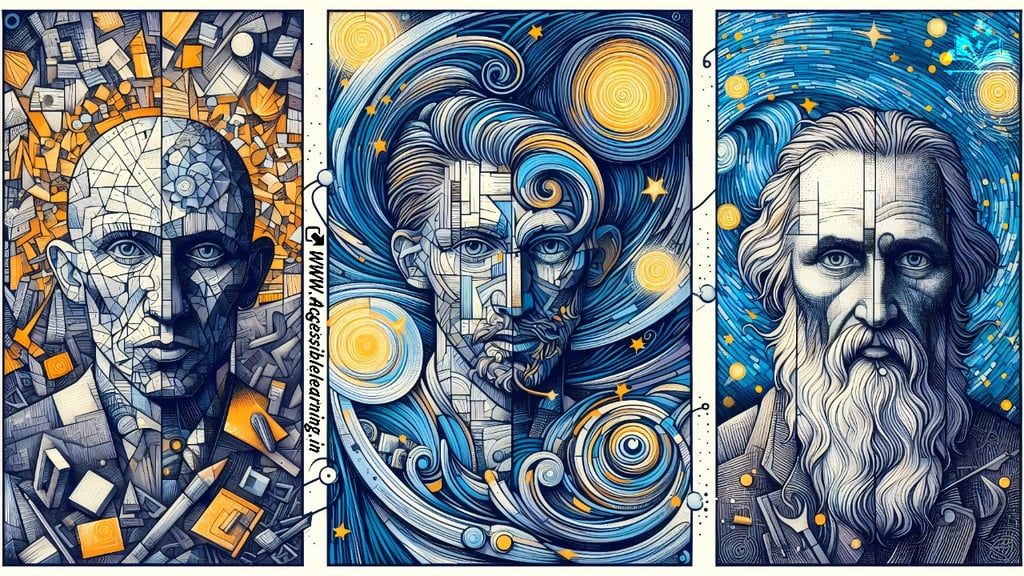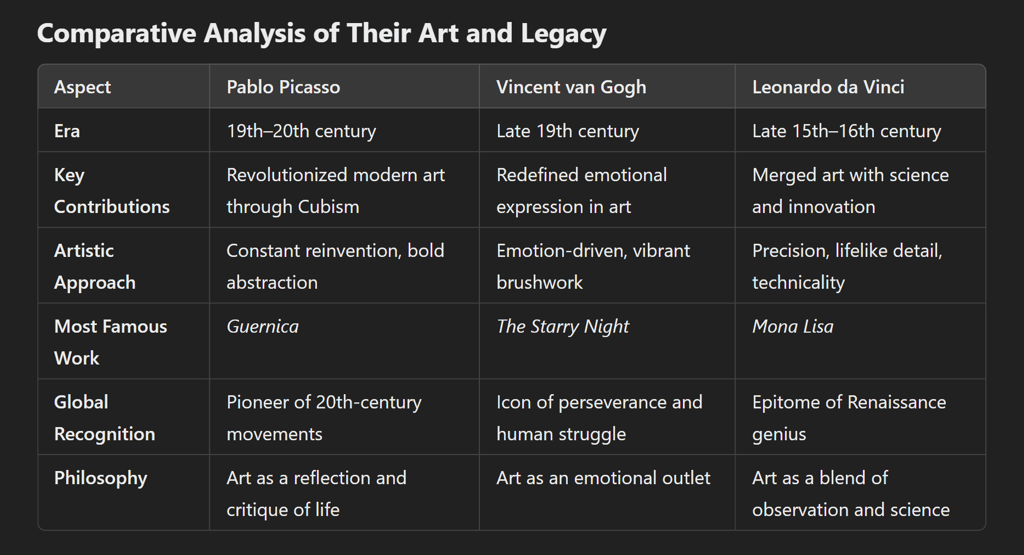
Artistic Titans: How Picasso, Van Gogh, and Da Vinci Shaped the World?!
Explore the artistic brilliance of Pablo Picasso, Vincent van Gogh, and Leonardo da Vinci in this in-depth comparison. Discover their unique styles, philosophies, and lasting impact on the world of art, science, and culture.
SCIENCE/PHILOSOPHYEDUCATION/KNOWLEDGEBIOGRAPHY/HISTORYARTIST/CREATIVITY
Kim Shin
11/28/20246 min read


Art is a universal language, and few names resonate louder in its history than Pablo Picasso, Vincent van Gogh, and Leonardo da Vinci. While they lived in vastly different eras and embraced unique artistic styles, each left an indelible mark on the world of art. Here’s an in-depth comparison that celebrates their genius, contrasts their approaches, and explores their impact on the artistic landscape.
Pablo Picasso: The Artistic Chameleon
Lifespan: 1881–1973
Art Movement: Cubism, Surrealism, Expressionism, and more.
Exploration of Periods
Blue Period (1901–1904): Characterized by somber tones of blue and gray, reflecting themes of melancholy, poverty, and human struggle. Works like The Old Guitarist convey deep emotion.
Rose Period (1904–1906): Marked by warmer colors and themes of love and circus life, showing a softer side of Picasso’s personality.
Cubism (1907–1914): The groundbreaking movement fragmented reality into geometric shapes and redefined perspective. His iconic Les Demoiselles d’Avignon dismantled traditional notions of beauty and form.
Later Experiments: Picasso’s later years saw him embrace surrealism, abstract expressionism, and neoclassicism, showcasing his restless pursuit of artistic reinvention.
Cultural Impact
Picasso didn’t just reflect the world; he transformed it. His radical experimentation inspired countless movements in modern art, influencing artists like Jackson Pollock and Andy Warhol. His political works, such as Guernica, remain powerful critiques of war and human suffering.
Pablo Picasso: Beyond Cubism
Personal Life and Art
Picasso was deeply influenced by his Spanish roots, evident in the recurring themes of bullfighting and Mediterranean culture in his art.
His relationships, particularly with his muses and lovers, played a vital role in his artistic evolution. Women like Françoise Gilot and Dora Maar inspired some of his most iconic works.
Pioneering Mixed Media
Picasso experimented with mixed media long before it became mainstream. He incorporated everyday objects like newspapers, sand, and even chair caning into his collages, breaking barriers between fine art and craftsmanship.
Picasso’s Impact on Sculpture
Though primarily known as a painter, Picasso also reshaped modern sculpture. Works like Bull’s Head (crafted from a bicycle seat and handlebars) display his genius in reimagining mundane objects as art.


Vincent van Gogh: The Epitome of Passion
Lifespan: 1853–1890
Art Movement: Post-Impressionism
Themes in Van Gogh's Work
Nature as a Mirror of Emotion: Van Gogh’s landscapes, such as Wheatfield with Crows and The Starry Night, are imbued with his emotional struggles and admiration for nature’s beauty.
Portraits of Humanity: His series of portraits, including The Potato Eaters and Self-Portrait with Bandaged Ear, reveal his empathy for ordinary people and his inner battles.
Obsession with Light and Color: Influenced by Impressionism and Japanese art, van Gogh’s work is characterized by bright yellows, swirling blues, and thick, expressive brushstrokes that bring his emotions to life on canvas.
Struggles and Triumphs
Despite producing over 800 paintings and 1,200 sketches in just over a decade, Van Gogh sold only one painting in his lifetime. Plagued by mental health issues and a sense of isolation, his tragic death at 37 marked the end of a life filled with unfulfilled dreams. Today, however, his art fetches millions, and he is regarded as one of the most beloved artists in history.
Vincent van Gogh: The Spiritual Connection to Art!
Influences on Van Gogh’s Style
His earlier works were inspired by the Dutch Golden Age painters like Rembrandt, focusing on somber tones and social realism. Later, exposure to Impressionism and Japanese ukiyo-e prints introduced brighter colors and bold compositions.
Van Gogh’s admiration for Japanese art influenced his landscapes, as seen in The Bridge in the Rain. He called Japan "a land of light," which greatly inspired his own artistic vision.
Art as Therapy
For van Gogh, painting was more than a profession; it was a way to cope with his emotional turmoil. His vivid, rhythmic brushstrokes reveal the therapeutic power of creativity.
Letters to his brother Theo reflect his thoughts on art, nature, and human suffering, showcasing his philosophical side and deep understanding of art as a mirror of life.
Legacy in Mental Health Conversations
Van Gogh’s struggles with mental illness have made him a symbol of resilience in the face of adversity. He is now celebrated not just for his art but as an emblem of the tortured artist’s unwavering passion.


Leonardo da Vinci: The Universal Genius!
Lifespan: 1452–1519
Art Movement: High Renaissance
More Than an Artist
Leonardo da Vinci was the quintessential Renaissance man, excelling in painting, anatomy, engineering, architecture, and even weapon design. His notebooks, filled with sketches and scientific observations, reveal an insatiable curiosity about the world.
Techniques That Defined a Legacy
Sfumato: The soft blending of colors and tones, as seen in the Mona Lisa, creates a lifelike, mysterious effect.
Anatomical Precision: Da Vinci’s deep understanding of anatomy, acquired through dissection, lent his art an unparalleled realism. His Vitruvian Man remains a symbol of the harmony between art and science.
Innovative Composition: Works like The Last Supper demonstrate his mastery of perspective and balance, creating visual narratives that captivate viewers centuries later.
Influence Across Disciplines
Leonardo’s genius extended beyond art. His designs for flying machines, hydraulic systems, and weaponry were far ahead of their time, laying the groundwork for future scientific advancements.
Leonardo da Vinci: The Pioneer of Modern Thinking!
Scientific Contributions in Art
Leonardo’s art was deeply intertwined with his scientific explorations. His studies of light, anatomy, and perspective gave his works an unmatched realism and depth.
His anatomical sketches, such as The Fetus in the Womb, are considered masterpieces of both science and art, revealing the intricacies of the human body centuries before modern medicine.
Art as Innovation
Leonardo’s fascination with optics led him to explore how light interacts with objects. This interest shaped his masterpiece, The Last Supper, where the interplay of light and shadow enhances its dramatic intensity.
His meticulous attention to detail meant many projects were left unfinished, as he often sought perfection beyond what was achievable in his time.
Cultural Symbolism of His Works
The Mona Lisa transcends its artistic brilliance to become a symbol of mystery, often interpreted through countless theories about her smile and identity.
The Last Supper revolutionized religious art by portraying biblical characters with human expressions, emphasizing their emotional and spiritual struggles.


Comparative Philosophies of Art!
Picasso’s Boldness
Picasso saw art as a tool for transformation and reinvention. His philosophy was grounded in the idea that “every act of creation is first an act of destruction.” He constantly broke conventions to pave new paths in the art world.
Van Gogh’s Emotional Connection
For van Gogh, art was deeply personal—a medium to express his soul. He believed in art’s ability to connect humanity to nature and to the divine, making his works profoundly spiritual.
Da Vinci’s Pursuit of Perfection
Leonardo treated art as a science, approaching each work with unparalleled precision. His philosophy was rooted in the Renaissance ideal of harmony between intellect and creativity.
Modern Influence and Popularity
Art Market
Picasso’s works dominate modern art auctions, with Les Femmes d’Alger (Version O) selling for $179.4 million in 2015. Van Gogh’s Portrait of Dr. Gachet fetched $82.5 million, while da Vinci’s Salvator Mundi became the most expensive artwork ever sold at $450.3 million in 2017.
Pop Culture Presence
Picasso's name is synonymous with modern art movements.
Van Gogh’s life story has inspired films (Loving Vincent), songs (Vincent by Don McLean), and even immersive art experiences.
Leonardo’s inventions and paintings are referenced in countless adaptations, from The Da Vinci Code to museum exhibits exploring his genius.
Why Their Art Still Matters
Timeless Appeal: Each artist’s work speaks to universal themes—Picasso’s rebellion, van Gogh’s vulnerability, and da Vinci’s curiosity resonate across generations.
Diverse Influence: Their art has inspired movements far beyond painting, influencing literature, music, architecture, and even technology.
Enduring Mystique: Whether it’s decoding the meaning behind Picasso’s abstraction, van Gogh’s swirling skies, or da Vinci’s enigmatic smiles, their art invites endless interpretation.
The Legacy of Three Titans
Picasso’s Modern Influence
Picasso inspired the deconstruction and reconstruction of art forms. His experimentation paved the way for abstract art, making him a foundational figure in modern artistic movements.
Van Gogh’s Enduring Humanity
Van Gogh’s personal struggles resonate with audiences, making him a symbol of the artist’s journey. His works continue to inspire empathy and hope, proving that beauty often emerges from pain.
Da Vinci’s Renaissance Perfection
Leonardo’s legacy is unmatched in its breadth. His ability to combine art with science made him not just an artist but a visionary who changed how we see the world.

Though Picasso, van Gogh, and da Vinci belong to different worlds in terms of time, style, and philosophy, their collective impact is immeasurable. Each artist offers a unique lens to view art: Picasso invites us to challenge convention, van Gogh urges us to find beauty in struggle, and da Vinci shows us the power of blending creativity with intellect.
Their masterpieces continue to captivate, reminding us that art is not just about technique but about reflecting the human spirit in its many forms. Whether you’re drawn to Picasso’s audacity, van Gogh’s vulnerability, or da Vinci’s brilliance, these legends prove that art is eternal, evolving, and essential.
Subscribe To Our Newsletter
All © Copyright reserved by Accessible-Learning Hub
| Terms & Conditions
Knowledge is power. Learn with Us. 📚


